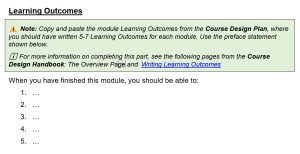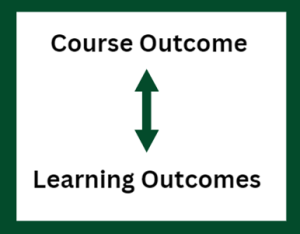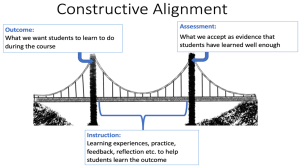6 Writing Learning Outcomes
Defining Module Outcomes
The figure above shows a bridge with a student preparing to walk across it. For the learner to successfully cross the bridge from the start of the course until they use what they learn in the course, there needs to be alignment.
Establishing Clear and Measurable Learning Outcomes
As shown in the image above, determining the learning outcomes is the first step in the design of a course. They are the destination you want students to reach by the end of the course. Everything else such as assessment (how you’ll know if you reached your destination) and learning activities (the route you’re going to take) come later.
“Learning outcomes are statements of what a student is expected to know, understand and/or be able to demonstrate after completion of a process of learning (Kennedy, 2007, p. 21).” Establishing clear and measurable learning outcomes is essential to shape the development of online course content. Outcomes support in the creation of formative and summative assessments and ensures accurate measurement of student achievement. Learning outcomes are crucial for fostering accountability and evaluating programs, allowing continuous improvement in teaching practices, and facilitating institutions in showcasing adherence to accreditation standards.
Effective learning outcomes include three parts:
- Performance – “The student should be able to”: do what?
- Condition – the condition, circumstance or environment in which student learning will occur or be demonstrated (e.g. in a classroom or lab, on a project or exam, given specific equipment or resources, etc.)
- Criteria – the type, quantity, quality/standard, accuracy, degree to, completion time
How to Write Learning Outcomes
The Writing Learning Outcomes Chart states that effective outcomes are specific, measurable, attainable, relevant, timely, straightforward, and student-centered. Action Verbs for Learning Outcomes are required to clearly specify the expected behaviours that students should demonstrate within your module. This clarity helps both instructors and students understand the expectations and facilitates assessment of student achievement. Additionally, action verbs found in the Bloom’s Taxonomy Staircase promote active learning by emphasizing the performance and application of knowledge and skills through a leveled progression of cognitive activity.
When creating learning outcomes, it is important to think about aligning them with real-world contexts to help students develop the competencies needed to tackle professional challenges. This relevance ensures that learning is transferable, allowing students to apply their knowledge and skills in various situations. By linking outcomes to real-world scenarios, students are better equipped for success, fostering a more comprehensive educational experience that enhances critical thinking through experiential learning methods beyond traditional lectures (Krain, 2010).
Sample formula to write learning outcomes:
will be able to (measurable verb) + (learning statement)
Adapted from (Course objectives & learning outcomes, DePaul, n.d)
To ensure that your learning outcomes are effective you can use the Writing Learning Outcomes Chart to support drafting learning outcomes, assessing them based on specific criteria, and revising them to align with the course context.
Example Learning Outcomes:
- Students should be able to explain the need for a chosen initiative to have financial resources dedicated to through an in-class debate.
- Students should be able to calculate the circumference of a cylinder on an exam without using a calculator.
- Students should be able to provide the required care for perennial plants growing in the course plot.
Your learning outcomes that you create can then be added to the Module Template to support your course development.

Aligning Outcomes with Overall Course Outcomes
Why build alignment?
When learning outcomes align with course outcomes, both instructors and students gain a clear understanding of expectations, promoting clarity and coherence within your online course. This alignment adds meaning to the learning and teaching processes (Lam & Tusi, 2017). Proper alignment facilitates the design of assessments that accurately measure student achievement of the intended learning goals and helps students see the relevance of their learning experiences.

Constructive Alignment
Constructive alignment is the concept that your learning outcomes, assessments, and learning strategies should align. How students are doing or have done toward reaching the learning outcomes will be measured by the assessments you choose. Learning strategies are the activities you and students will engage in to help learners progress toward the stated outcomes. This video explains this in greater detail.
Additional Resources:
References:
DePaul. (n.d.). Course objectives & learning outcomes. Course Objectives & Learning Outcomes | Course Design | Teaching Guides | Teaching Commons | DePaul University, Chicago. https://resources.depaul.edu/teaching-commons/teaching-guides/course-design/Pages/course-objectives-learning-outcomes.aspx
Kennedy, D. (2007). Writing and using learning outcomes: a practical guide. https://cora.ucc.ie/server/api/core/bitstreams/88bdd1f3-4e1c-4cf8-baf4-df28d4f094c5/content
Krain, M. (2010). The effects of different types of case learning on student engagement. International Studies Perspectives, 11(3), 291–308. doi:10.1111/j.1528-3585.2010.00409.x
Lam, B., & Tsui, K. (2013). Examining the Alignment of Subject Learning Outcomes and Course Curricula Through Curriculum Mapping. Australian Journal of Teacher Education, 38(12). https://doi.org/10.14221/ ajte.2013v38n12.8

